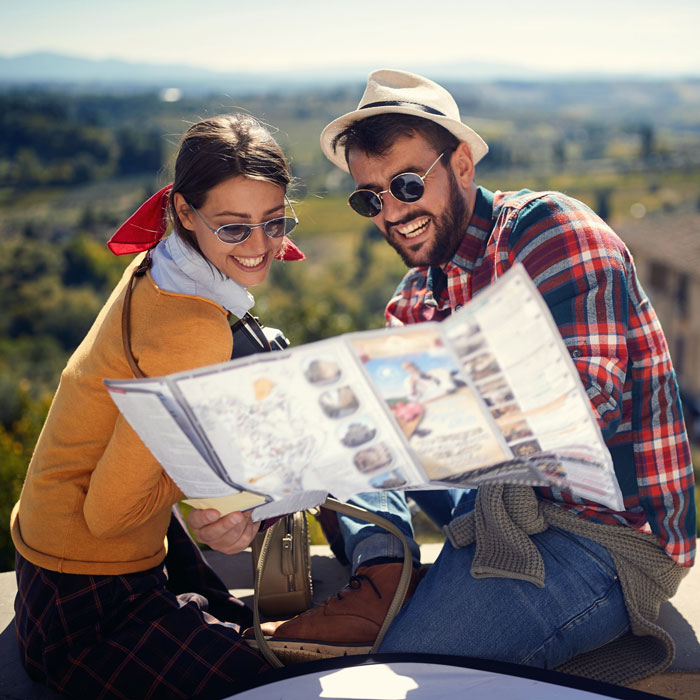In the year before the pandemic, wine tourism in Italy was at its peak: according to estimates by the "Turismo del Vino" observatory of the national association of wine towns "Città del Vino", around 15 million people took part in a tasting, cellar or vineyard tour as well as other events or stayed overnight in wineries in 2019. In the process, they generated a turnover of 2.65 billion euros - an increase of six and seven per cent, respectively, compared to the tendency of stable levels in previous years.

The fall was all the more brutal in the first Corona year of 2020, with turnover losses of 37 percent (gastronomy), 55 percent (hotel industry) to 76 percent (tour operators). Exact figures for Italian wine tourism are not available, however: The Observatory has decided against a static-quantitative in favour of a dynamic-qualitative future analysis. According to the 100 industry representatives interviewed for this purpose, it should take about two years until visitor and turnover figures return to pre-pandemic levels. Surveys on how well suppliers could already recover in 2021 are still underway. However, it is already certain that wine tourism will have to cope with the pandemic and its aftermath once it is over - and will change forever as a result.
One immediate effect of Covid: Tuscany will continue to expand its pioneering role in wine tourism. Whereas 45 percent of wine travellers previously chose it as their favourite destination, almost 53 percent of Italians and even more than 60 percent of international guests now give it preference - far ahead of Piedmont (around 18 percent), Veneto and Sicily (around 6.5 percent each). The reason for this growth lies in the added value that the region has to offer with history, art and culture, but also with suitable hospitality and accommodation offers. Tuscany developed wine tourism earlier than other regions - and is now benefiting from this head start in experience.
Apparently, in the land of the Medici, Leonardo and Michelangelo, it was recognised in good time that wine travellers do not just want to taste wine technically, but want to experience wine emotionally and sensually in its natural and cultural context. This trend is likely to be further strengthened by the experience of the pandemic: tasting at a distance outside rather than in a cramped cellar and preferring to do so in a small group of friends rather than anonymously among many strangers. Admittedly, such "terrazza feeling" is not really new, but has been inspiring Tuscan factions of the most diverse origins for decades. But the pandemic has raised awareness of safe and healthy wine experiences and made well-being a basic need, explains Roberta Garibaldi, professor of tourism management at the University of Bergamo and president of the Italian Wine and Gastrotourism Association, in her current trend report.
According to this report, consumer-oriented wine and gastro tourism is a thing of the past. Those who visit a wine-growing region want to build a sustainable relationship with it. This means taking care of oneself, the environment and the people. It is about an expanded understanding of sustainability in the sense of not only ecological, but also social culinary art. This is associated with a temporal dissolution of the travel experience: People choose their destination in advance on the basis of virtual tours and tastings, they move as slowly as possible on site by trekking or biking, and then they act as ambassadors for the region among their friends. To support such growing needs, digital marketing through the web and apps, clubs and e-commerce is becoming increasingly important.

Practical experience confirms this perspective: "The concept of 'cellar tour with tasting' is outdated, visitors are no longer satisfied with that," explains Emanuela Tamburini from the winery of the same name in Gambassi Terme. She is president of the Tuscany Movimento Turismo del Vino (MTV) association, which includes around 100 wineries throughout the region. "Today's wine tourists want more, namely something unique like a special barrel tasting, often also something family-friendly like a picnic in the vineyard, in any case something tailor-made. They want to enjoy their time at the winery to the fullest."
Above all, the desire for experiences in the fresh air, in the great outdoors, has never been as great as since the pandemic. MTV has reacted to this by cooperating with third parties, for example, to make the businesses bicycle-friendly. Furthermore, events are organised with municipalities, local restaurants and hotels, such as open cellar days or tastings under the stars, which offer emotional added value beyond the tasting. "Organising a sensory-professional tasting is not a trivial thing, you need qualified staff to do it," Emanuela Tamburini points out. "That's why we were among the first to focus on specific training and further education for wine tourism employees. This includes knowledge of at least English - although one foreign language is no longer enough - of oenology and agronomy, but also the ability to interact with wine tourists and understand their needs."
Investments in staff, suitable rooms and equipment for excursions cost money. Emanuela Tamburini therefore believes it is justified that tastings today are usually no longer free of charge: "They are no longer an end in themselves, but an all-round experience lasting one or two hours, for which appropriately trained staff must be employed. Even before the pandemic, fewer and fewer tourists came by car, but only with hand luggage on cheap flights. They can't take wine with them because of this, and they are more comfortable paying for the unique tasting experience that will be remembered, rather than feeling obliged to buy wine."
Indeed, previous visitors refreshed their memories during the pandemic by attending online tastings and ordering from the web shop. "Businesses that understand the importance of customer service after the winery visit have suffered less from the effects of the pandemic and the absence of tourists," Emanuela Tamburini knows. Apparently, the losses in wine tourism were at least partially compensated by better wine sales: in 2021, at any rate, Italy's wine exports rose by 12.4 per cent to a new record of 7.1 billion euros.
Nevertheless, Tuscany is hoping for a significant improvement in wine tourism as early as this year - and especially for a return of Americans after two years of absence: those who mainly deal with overseas visitors had to cope with double the losses than those who dealt with Europeans beforehand, as most of them could return as early as 2021. How the recent deterioration in the international situation will play out can hardly be estimated at present. Until the outbreak of the war in Ukraine, the signs for 2022 were very positive, according to Emanuela Tamburini, but since then they have dimmed. But wineries, with their range of wine experiences in nature, are just the right hosts to satisfy wine travellers' need for a safe, healthy and sustainable break from pandemics and Putin.
Photos: © 123rf.com